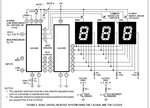skarkowtsky
Advanced Member level 4

Hi all,
I'm an amateur replica movie prop maker, though completely unskilled with circuits. I'd like to re-create a briefcase that contains a thumb wheel switch and 12 4-digit LED readouts. I've identified the actual thumbwheel, a Digitran 23000.
The case should work as follows. Each 4-digit LED has its own toggle switch. In one position, the readout is off, in another it is on, revealing a 4-digit number. Whether it actually, functions or not, the end result is that the character in the movie dials in a number on the thumbwheel, flips a switch to one of the 4-digit LEDs, and the number is revealed, he then dials in another number, flips another switch, and that number is revealed on a different LED. He does this "12" times over two scenes in the movie.
I can't say that the prop functions for sure, but we do see him dial in 2 different numbers that reveal themselves on two separate readouts. They could have been pre-programmed, and he just spun a disconnected thumbwheel, or it could have actually functioned. It's all housed in transparent plexiglass, and I can see a lot of components and wires underneath. Again, these could all be dummies, or not.
The actual prop is owned by a fan, and although he won't reveal much of anything about it, he did state that the switches and readouts do function. He wouldn't say whether or not the 4-digit numbers were burned in to each readout, or if the thumbwheel controlled them. He also stated that the entire case is powered by (2) 9 volt batteries.
I do think it actually functions because there is what appears to be a glitch in the readouts when we first see the case. At first, the character is just getting started and only one of the 12 LED readouts is lit. It shows the number 1260. On the thumbwheel is 1160, and the character then flips a second switch that shows 1160 on a second LED readout. At the same time, the LED with 1260 changes to 1160, too. This seems like a bad wiring job, but it also seems like the wheel is actually driving the LEDs. If all the LEDs were pre-programmed, the first wouldn't have changed to the new number, right?
The movie was released in 1988, so please think about technology from that era when considering how to make this.
A huge thanks in advance!
John
I'm an amateur replica movie prop maker, though completely unskilled with circuits. I'd like to re-create a briefcase that contains a thumb wheel switch and 12 4-digit LED readouts. I've identified the actual thumbwheel, a Digitran 23000.
The case should work as follows. Each 4-digit LED has its own toggle switch. In one position, the readout is off, in another it is on, revealing a 4-digit number. Whether it actually, functions or not, the end result is that the character in the movie dials in a number on the thumbwheel, flips a switch to one of the 4-digit LEDs, and the number is revealed, he then dials in another number, flips another switch, and that number is revealed on a different LED. He does this "12" times over two scenes in the movie.
I can't say that the prop functions for sure, but we do see him dial in 2 different numbers that reveal themselves on two separate readouts. They could have been pre-programmed, and he just spun a disconnected thumbwheel, or it could have actually functioned. It's all housed in transparent plexiglass, and I can see a lot of components and wires underneath. Again, these could all be dummies, or not.
The actual prop is owned by a fan, and although he won't reveal much of anything about it, he did state that the switches and readouts do function. He wouldn't say whether or not the 4-digit numbers were burned in to each readout, or if the thumbwheel controlled them. He also stated that the entire case is powered by (2) 9 volt batteries.
I do think it actually functions because there is what appears to be a glitch in the readouts when we first see the case. At first, the character is just getting started and only one of the 12 LED readouts is lit. It shows the number 1260. On the thumbwheel is 1160, and the character then flips a second switch that shows 1160 on a second LED readout. At the same time, the LED with 1260 changes to 1160, too. This seems like a bad wiring job, but it also seems like the wheel is actually driving the LEDs. If all the LEDs were pre-programmed, the first wouldn't have changed to the new number, right?
The movie was released in 1988, so please think about technology from that era when considering how to make this.
A huge thanks in advance!
John



